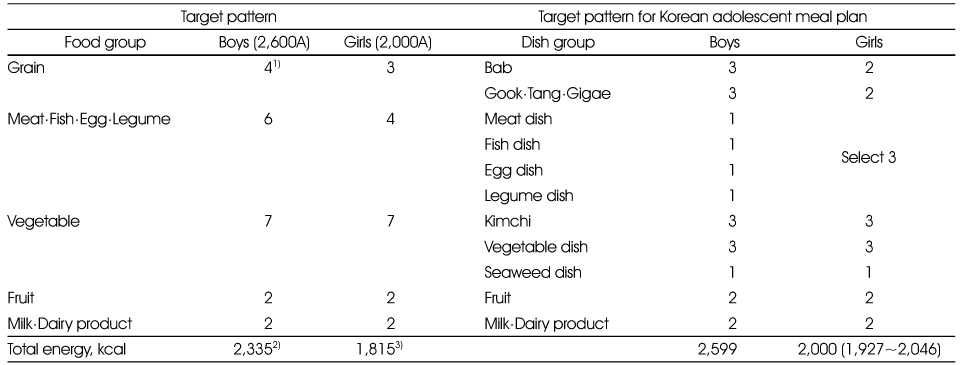Articles
- Page Path
- HOME > Korean J Community Nutr > Volume 20(1); 2015 > Article
-
Research Article
- Revision of the Target Pattern based on Single Serving Size of Dishes for Korean Adolescent Meal Plan
- Mi Jin Park, Youngnam Kim
-
Korean Journal of Community Nutrition 2015;20(1):21-29.
DOI: https://doi.org/10.5720/kjcn.2015.20.1.21
Published online: February 28, 2015
Department of Home Economics Education, Korea National University of Education, Chungbuk, Korea.
- Corresponding author: Youngnam Kim. Department of Home Economics Education, Korea National University of Education, 250 Taeseongtabyeon-ro, Cheongju, Chungbuk 361-892, Korea. Tel: (043) 230-3709, Fax: (043) 231-4087, youngnam@knue.ac.kr
Copyright © 2015 The Korean Society of Community Nutrition
This is an Open-Access article distributed under the terms of the Creative Commons Attribution Non-Commercial License (http://creativecommons.org/licenses/by-nc/3.0/) which permits unrestricted non-commercial use, distribution, and reproduction in any medium, provided the original work is properly cited.
- 878 Views
- 3 Download
- 4 Crossref
Figure & Data
REFERENCES
Citations

- Representative Nutrients Contents and Nutritional Adequacy Evaluation of Single-Dish Meal for Middle School Students
Gisun Lee, Youngnam Kim
Korean Journal of Community Nutrition.2018; 23(2): 93. CrossRef - Nutritional Adequacy Analysis of Recommended Menu in Dietary Reference Intakes for Koreans 2015
Youngnam Kim
Korean Journal of Community Nutrition.2017; 22(4): 279. CrossRef - Proposition and Application of a Dish-Based Target Pattern for Korean Adolescent Girls
Mi Jin Park, Youngnam Kim
Korean Journal of Community Nutrition.2015; 20(2): 87. CrossRef - Validation of Nutrient Intake Estimation based on One Serving Size
Yi-Yeong Kim, Mi-Hyun Kim, Mi-Kyeong Choi
The Korean Journal of Food And Nutrition.2015; 28(5): 871. CrossRef
Substitution of representative dish1) to CAN Pro 4.0 dish
1) Select from In-depth seasonal linkage analysis of foods and nutrition intakes for infants, children, and adolescent (Korea Health Industry Development Institute 2010)
Dish group in target pattern for Korean adolescent meal plan
Intake quantity and weighed value of dish in target pattern for Korean adolescent meal plan
1) dish with weighed value of ≥ 0.05
2) Data from In-depth seasonal linkage analysis of foods and nutrition intakes for infants, children, and adolescent (Korea Health Industry Development Institute 2010)
3) Number of dishes listed/Total number of dishes included for weighed value calculation
Representative nutritional value of each dish in target pattern for Korean adolescent meal plan
Comparison of caloric contents of meat·fish·egg·legumes dish in target pattern and target pattern for Korean adolescent meal plan
1) multiples of 1 serving size
2) Representative energy value of meat·fish·egg·legume: 94 kcal/serving size
3) Representative energy value: meat dish, 214 kcal; fish dish, 125 kcal; egg dish, 95 kcal; legume dish, 130 kcal
Serving assignment of food and dish groups in target pattern and target pattern for Korean meal plan
1) Multiples of 1 serving size
2) Excluded 6 servings of fat·sugar as condiment (230 kcal)
3) Excluded 4 servings of fat·sugar as condiment (153 kcal)
Energy content and energy contribution ratio of carbohydrate, protein, and fat1) in target pattern for Korean meal plan
1) Calculation by representative nutrition value for dish groups and assigned numbers of serving
2) Applying average representative value of (Meat+Fish+Egg), (Meat+Fish+Legume), (Meat+Egg+Legume), and (Fish+Egg+Legume)
Nutritional adequacy of minerals and vitamins1)
1) Calculation by representative nutrition value for dish group and assigned number of serving
2) Calculation by applying average representative value of (Meat+Fish+Egg), (Meat+Fish+Legume), (Meat+Egg+Legume), and (Fish+Egg+Legume)
1) Select from In-depth seasonal linkage analysis of foods and nutrition intakes for infants, children, and adolescent (Korea Health Industry Development Institute 2010)
1) dish with weighed value of ≥ 0.05 2) Data from In-depth seasonal linkage analysis of foods and nutrition intakes for infants, children, and adolescent (Korea Health Industry Development Institute 2010) 3) Number of dishes listed/Total number of dishes included for weighed value calculation
1) multiples of 1 serving size 2) Representative energy value of meat·fish·egg·legume: 94 kcal/serving size 3) Representative energy value: meat dish, 214 kcal; fish dish, 125 kcal; egg dish, 95 kcal; legume dish, 130 kcal
1) Multiples of 1 serving size 2) Excluded 6 servings of fat·sugar as condiment (230 kcal) 3) Excluded 4 servings of fat·sugar as condiment (153 kcal)
1) Calculation by representative nutrition value for dish groups and assigned numbers of serving 2) Applying average representative value of (Meat+Fish+Egg), (Meat+Fish+Legume), (Meat+Egg+Legume), and (Fish+Egg+Legume)
1) Calculation by representative nutrition value for dish group and assigned number of serving 2) Calculation by applying average representative value of (Meat+Fish+Egg), (Meat+Fish+Legume), (Meat+Egg+Legume), and (Fish+Egg+Legume)

 KSCN
KSCN








 Cite
Cite


